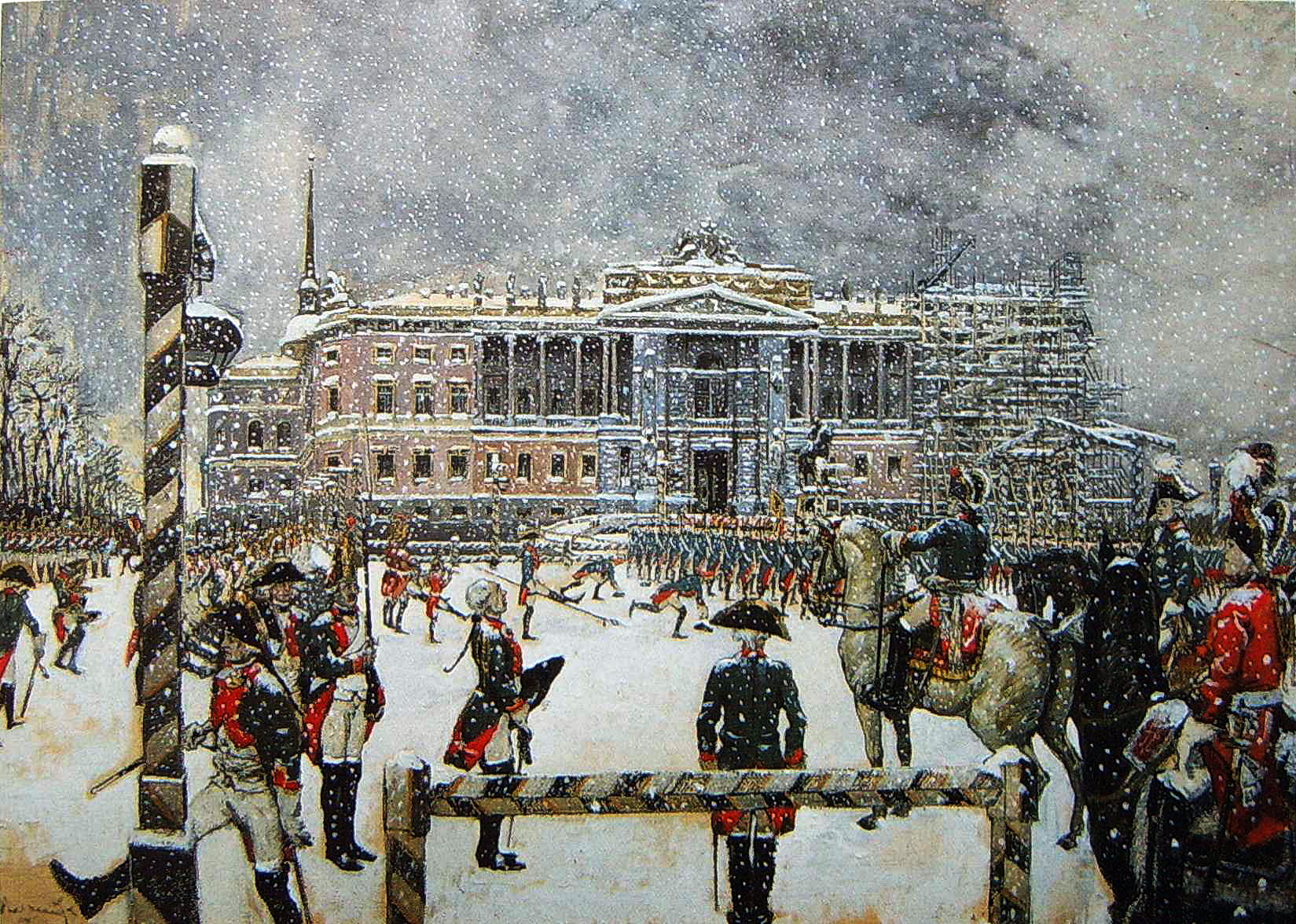
Military Parade of Emperor Paul in front of Mikhailovsky Castle painting by Alexandre Benois
Paul made several idiosyncratic and deeply unpopular
attempts to reform the army. Under Catherine’s reign, Grigori Potemkin
introduced new uniforms that were cheap, comfortable, and practical, and
designed in a distinctly Russian style. Paul decided to fulfil his predecessor
Peter III’s intention of introducing Prussian uniforms. Impractical for active
duty, these were deeply unpopular with the men, as was the effort required to
maintain them. His love of parades and ceremony was not well-liked either. He
ordered that Wachtparad (“Watch parades”) take place early every
morning in the parade ground of the palace, regardless of the weather
conditions. He would personally sentence soldiers to be flogged if they made a
mistake, and on one occasion ordered a Guards regiment to march literally to
Siberia after they became disordered during maneuvers, although he changed his
mind after they had walked about 10 miles (16 km). He attempted to reform the
organization of the army in 1796 by introducing The Infantry Codes, a series of
guidelines for the army based largely upon show and glamour. But his greatest
commander, Suvorov, completely ignored them, believing them to be worthless.
Paul strove to reshape the Russian army in the Prussian
fashion, introducing strict discipline and ridiculous wigs for soldiers. These
reforms fed discontent among officers and ordinary soldiers alike.
Among his first steps was the summoning of all guardsmen to
their regiments, which brought several surprising details to light. Most
officers had actually been in their country estates or villages deserting their
regiments, where they had also enlisted their children, whose ages were often
given as 18 when they were in fact not even 10. The widespread practise of
enrolling the nobles’ infants into the army to provide them with a ‘deserved’
officer rank by the age of 16 – 17 was forbidden.
Paul also forbade army officers from coming to military
exercises in their six or four horse driven carriages and wear fur coats or
muffs, as this was not part of their uniform. To avoid freezing in cold weather
(the average temperature in St. Petersburg in February 1799 was minus 37C)
officers had to wear woolen sweaters beneath their jackets or line them with
fur.
Russian soldiers were notorious for their fighting capacity
and staying power: prior to the campaign of 1812 Napoleon’s worst experience on
the battlefield had come at the hands of General Bennigsen at the battle of
Eylau, whilst in the Seven Years’ War Frederick the Great had repeatedly been
very roughly handled by the green-coated soldiers of the Empress Elizabeth,
gaining an extremely pyrrhic victory over them at Zorndorf in 1758 and going
down to ignominious defeat at Kunersdorf in 1759. Other Russian victories from
the same war numbered Gross-Jägersdorf and Kay, whilst in 1799 General
Suvorov’s invasion of Switzerland had seen Russian troops gain a series of
dramatic successes: on 1 October, for example, 5000 troops under General
Rosenberg had utterly defeated a column of more than twice as many Frenchmen
under no less a figure than André Masséna, a general who is always rated as one
of Napoleon’s greatest commanders. In all this the self-same factors generally
identified as the mainspring of Russian patriotism in 1812 had made an
appearance. Thus, throughout the eighteenth-century commanders such as
Rumiantsev and Suvorov had made every effort to play on the devotion of the
soldiery to the Orthodox faith and to instill love of the tsar. In this respect
it is the opinion of some historians that they appear to have had at least some
success.
Three months after the first battle of Zurich, a reinforced
Marshal Massena’s found himself in another unenviable position of having to
fend off vastly greater numbers of Russians under the legendary Field Marshal
Suvarov. The French commander, however, acted with a Bonapartish style and,
after sending a small force to slow Suvarov’s progress through the passes,
rounded on the other Russian army under General Alexander Korsakov. He smashed
into the Russians and scattered them, causing 8000 casualties and capturing
supplies, baggage and cannons. Then, Massena turned on Suvarov and in a
brilliant offensive operation drove him away – killing, wounding and capturing
almost 14,000 Russians.
The Second Battle of Zürich (25-26 September 1799) was a
French victory over an Austrian and Russian force near Zürich. It broke the
stalemate that had resulted from the First Battle of Zürich three months
earlier and led to the withdrawal of Russia from the Second Coalition.
The 1799 Campaign in Italy: General Suvorov’s Arrival in Italy (April 14, 1799)